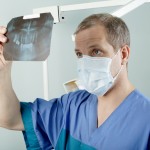
Dentigerous cysts are the second commonest bone cysts affecting between 0.9% to 7.3% of the population. Commonly they are associated with lower third molars, upper canines and lower premolars leading to delayed on non-eruption of the affected tooth. Those associated with third molars are usually extracted while those associated with canines or premolars may be observed following marsupialisation. Some may spontaneously erupt others may require orthodontic traction.
The aim of this review was to identify factors influencing eruption of teeth associated with dentigerous cysts.
Methods
Searches were conducted in the Pub Med, Embase, and the Cochrane Central Register of Controlled Trials supplemented by searches of the journals, The American Journal of Orthodontics and Dentofacial Orthopedics, International Orthodontics, the Journal of Clinical Orthodontics, the Journal of Oral and Maxillofacial Surgery, the Journal of Maxillofacial and Oral Surgery, the Journal of Stomatology, Oral and Maxillofacial Surgery, BMC Oral Health, the Journal of Clinical Pediatric Dentistry, the Journal of Clinical and Experimental Dentistry, and the Journal of Dentistry for Children.
Randomised clinical trials (RCTs), prospective controlled clinical trials (CCTs), case series, observational studies, review articles, and retrospective studies involving more than 5 cases of dentigerous cyst associated teeth were considered. Only studies published in English were included. Two reviewers independently searched for and selected studies, extracted data and assessed risk of bias using the ROBINS-I (Risk of Bias In Nonrandomized Studies of Interventions) tool and the Newcastle– Ottawa Quality Assessment Scale . Random and fixed effects meta-analyses were performed, and the GRADE approach was used to evaluate the certainty of the evidence.
Results
- 4 single-centre retrospective studies were included.
- All 4 studies focused on lower premolars.
- All 4 studies were considered to be a critical risk of bias.
- For spontaneous eruption after marsupialisation the risk ratio (RR) = 2.61(95%CI; 1.71 to 3.98)
- The certainty of the evidence was assessed as very low.
Conclusions
The authors concluded: –
The small number of published studies, as well as their heterogeneity and the critical risk of bias, did not allow the creation of evidence‐based protocols for managing teeth with dentigerous cyst safter marsupialisation. More high‐quality research is needed to draw more reliable conclusions.
Comments
The review authors have searched a good range of databases but as they note restricting the inclusion to English language publication may have excluded some relevant publications. Of the just over 3000 papers identified by their searches there were no clinical trials and ultimately only 4 small single-centre retrospective studies were included so the quality of the available evidence is very low. This needs to be taken into consideration when considering the findings. While the authors looked at age, stage of root formation, cusp depth, tooth angulation and eruption space the limited number of small studies and their poor quality prohibit any conclusions. Well conducted and reported prospective studies of appropriate sample size are needed to provide better evidence.
Links
Primary Paper
Nahajowski M, Hnitecka S, Antoszewska-Smith J, Rumin K, Dubowik M, Sarul M. Factors influencing an eruption of teeth associated with a dentigerous cyst: a systematic review and meta-analysis. BMC Oral Health. 2021 Apr 7;21(1):180. doi: 10.1186/s12903-021-01542-y. PMID: 33827533; PMCID: PMC8028237.
